
Picky eaters come in many forms.
There’s the baby who screams and knocks the bowl of squash on the floor because she wanted bananas. There’s the toddler who won’t eat her beans because they’re touching her rice. There’s the grade schooler who really despises the sight and smell of broccoli and grills you to see if there’s any of it hiding in whatever dish you made. There’s the husband who wants his food spicier or (ack!) smothered with cheese. There’s even me, a fully grown woman who still doesn’t like beets after trying them dozens of times.
There’s something inherently exhausting about planning and preparing a plant-based meal and then presenting it to a crowd who doesn’t seem to appreciate it at all.
So what’s a mom to do? Of course we know that a child often needs to try something many times before they learn to like it, but what does that process look like at a real family’s table? And what happens if they refuse to try it? Or they have tried it and still don’t like it? (Me and beets!)
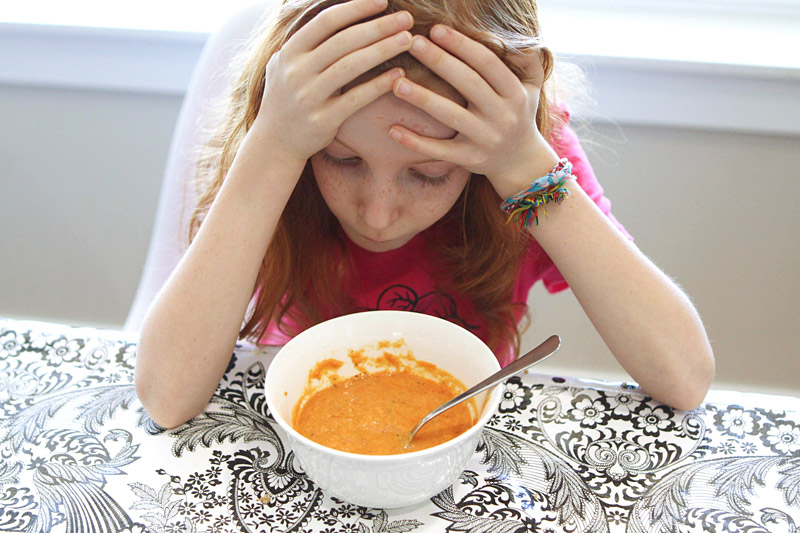
I have five children with a variety of food preferences and a foodie husband; we’ve been eating plant-based for over a decade. Here’s what I’ve learned to help picky eaters.

Principle #1: They’re Not Picky

We avoid the word “picky” around here when describing people. I use it in this article because it’s a popular term, but I think it pigeon-holes people into living up to the label.
I don’t refer to my kids as “picky.” Instead, I might say, “Potatoes aren’t your favorite, yet. Who knows, though? You might like them in this soup.”
“I know you prefer your tomatoes blended up, but they’re chunkier in this sauce.”
“My husband’s favorite foods tend to be ones with lots of spice and flavor.”
It’s totally cool to have food preferences. But being known as “picky” creates unnecessary tension.
Principle #2: Never criticize the food
This is also one of my keys to a pleasant meal experience with kids. I’m putting it near the top of the list for a reason.
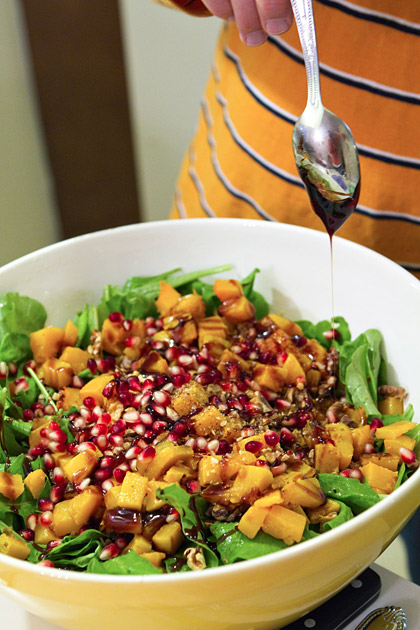
In our home, we teach our children from a very young age to only say positive things about the meal (and our efforts to prepare and present it), unless they are specifically asked for their feedback.
It is basic etiquette to compliment and/or express appreciation at the beginning of the meal. Even if you’re served something you find disgusting, you can thank the person for making it. My experience is that when you teach this at a neutral time (not when you’re frustrated because they turned up their nose at what you just served them), kids are happy to learn how to be polite.
It can be a game to find ways to compliment something they think they may not like. “It smells exciting!” “Thanks for making this, Mom. I’ve never had pasta like this before,” they may say as you pretend you served them shoelaces with spaghetti sauce.
At the dinner table, I can often tell how everyone likes the food just by watching how they eat it. But if I’m looking for more feedback, I may ask, “What do you think of this new pasta sauce?” My kids know they can answer “It’s not my favorite.” We practice that exact response a lot when they’re young, and it pays dividends for years to come. I may press them for details, and they can say they wish it didn’t have mushrooms in it, or they wish it wasn’t so salty or chunky.
Because they are withholding any critical comments until pressed, it does a few foundational things for our shared meal experience:
They aren’t voicing (and therefore reinforcing) a negative first impression. If they loudly proclaim they hate something, it will be that much harder for them to admit even to themselves that they like it later on!
It is infinitely nicer to serve something to a chorus of polite comments, even if some of them seem a little creative. 🙂
Note: This also applies to adults. That means my husband models this even when he doesn’t love what I cook, and it means when he prepares the meal I’m all (sincere) compliments and appreciation unless he specifically wants to know how I like what he made.
Principle #3: No pressure trying
We typically serve the kids their plates, and I put a little of everything on them. Sometimes, I ask them if they want “a little or a lot” of a given thing as I serve up, but usually they just get what they get.
When I can, I try to do the following, though:
Have at least one thing in the meal I know they like.
I do not short-order cook different meals for different people, and I prefer to keep meals simple without many (or any sides). We eat plant-based, so vegetables are usually the main dish. Simple.
However, if dinner is mushroom stroganoff, for example, and I know one of my kids really doesn’t like mushrooms (yet!), I’ll chop up an apple or grab some grapes and put some on each person’s plate. That way the kiddo can warm up to eating by choosing something friendly, rather than be confronted with a plate of only something they really dislike.
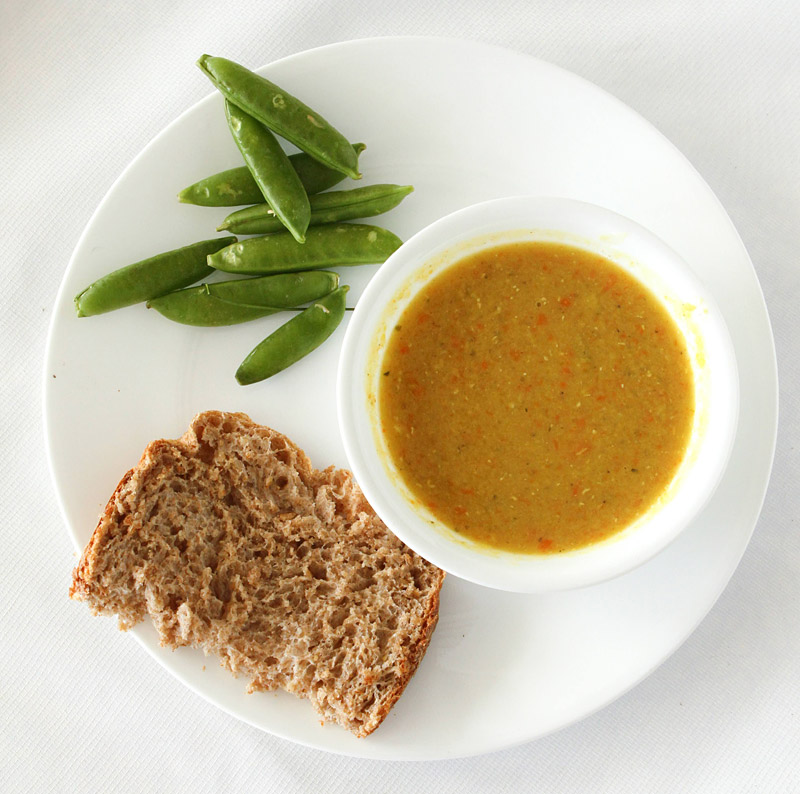
Serve in such a way they can eat-around the less favored thing.In the example of mushroom stroganoff, I would ideally put a pile of noodles on each plate, then top them with sauce, rather than sauce all the noodles and then serve. That means there will be some noodles around the outside that are plain or less saucy. Many times I’ve seen kids start eating around the outside, discover they like the sauce after all, and polish off the whole plate.
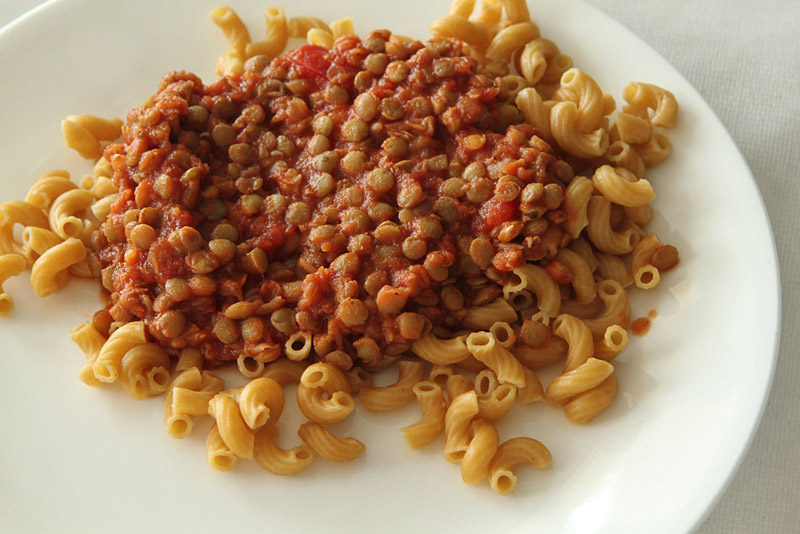
Serve small portions to start, but ask them to finish before asking for seconds
I love this approach! It means serving a small amount (5 bites) of that dreaded (delicious) stroganoff, plus the part of an apple or a half a piece of toast. There’s no pressure to eat anything on the plate, but if they eat it all and are still hungry, they can ask for seconds. When the amount is manageable, my kids will often just polish off the previously offensive item without any drama at all. Depending on the meal, seconds may look just like firsts (in which case they’d probably opt to eat the grapes or toast and finish their meal there), or seconds could honor some preferences, like plain noodles, or less-saucy noodles.Teach “polite bites” but avoid battles
We teach our kids that it’s polite to try something, but we don’t force it at the table.
In fact, we don’t force almost anything at the table. We try to keep things very positive and remind them of our policies in a cheerful or playful way. “I’d be happy to get you some more grapes as soon as you’re finished with what you were served first. We try not to waste food.”
Principle #4: Patience

We talk with our kids about not liking a food “yet,” because food preferences can change quite dramatically over time.
It would be wonderful if all our kids loved everything we made right away, but the best thing we can do is continue to make a variety of food and offer it with love (enforcing the atmosphere of appreciation as mentioned above).
I find that if my child doesn’t love what we had for lunch, he or she naturally eats more for dinner. If you’re offering a variety of healthy food at meals, having them not eat much at a meal is not a crisis.
The proportion of parents concerned about their kids not eating enough is far higher than the relatively rare situations where kids are truly not eating enough. If at their doctor’s checkup you see that their growth falls off their normal percentile, then that may be a cause for concern. Them not eating much of your lasagna? They’ll survive to eat another meal. Don’t feel like you have to cave and make an alternate dinner.
Principle #5: Hungrier kids are less picky
In a snacking-heavy culture, food is offered as a solution to any amount of temporary discomfort. But a kid who knows there’s a steady stream of granola bars and go-gurts available throughout the day is not particularly motivated to try the broccoli on their dinner plate.
If kids come to the table actually and truly hungry, they are far more likely to try foods and enjoy everything they’re served.
Consider limiting snacks in the hour or two leading up to dinner. And in our family, we limit snacks to mostly fresh or frozen vegetables, fresh fruit (1/day), or sometimes air-popped popcorn. My kids are usually more than ready to chow when I put a plate in front of them, even if something on it is unfamiliar.
Hunger is truly the best sauce!
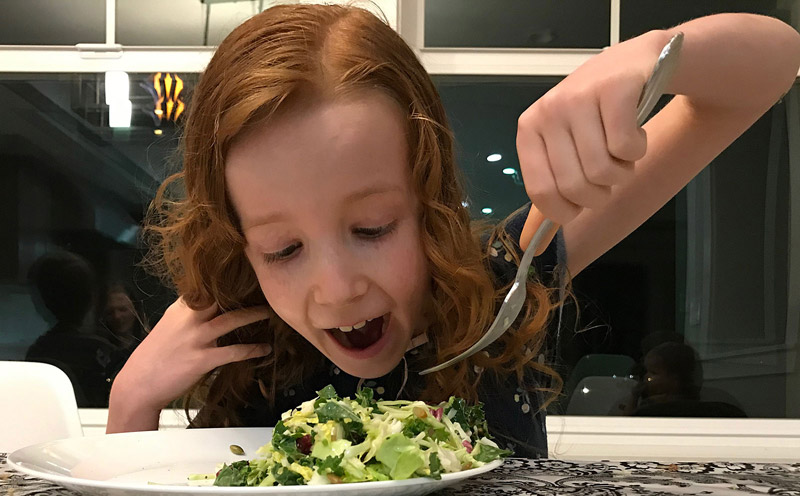
Several More Tips
My kids love being able to choose what’s for dinner periodically. This has an added benefit of letting them see that their favorite might not be someone else’s favorite and that’s ok. They know we have a variety of preferences and so we eat a variety of foods.
Don’t shy away from condiments. If you’ve got relatively healthy condiments that are fan favorites (think salsa, hot sauce, soy sauce, mustard, and the like), let them join the table. My husband will reach for the hot sauce if he finds my curry too mild, and I have a couple of kids that think salsa solves anything.
We didn’t spend very long in the “baby food” phase, and never actually bought baby food. Generally, we just gave our babies whatever we were having for a meal. I believe that not sticking with bland and pureed foods helped our kids develop a taste for stronger flavors and a variety of textures early on.

Connect kids to the food. Plant a garden. Go pick your fruit in a field or orchard. Bring your children to the grocery store and have them help you pick the biggest head of kale or decide whether to get big or baby carrots. Let them count out the sweet potatoes. And of course, if you can brave them in the kitchen, do it! If you’re looking for more guidance and structure in having kids in the kitchen, we took a fun online course that teaches kids step-by-step knife skills, measuring skills, etc. for all different age levels.
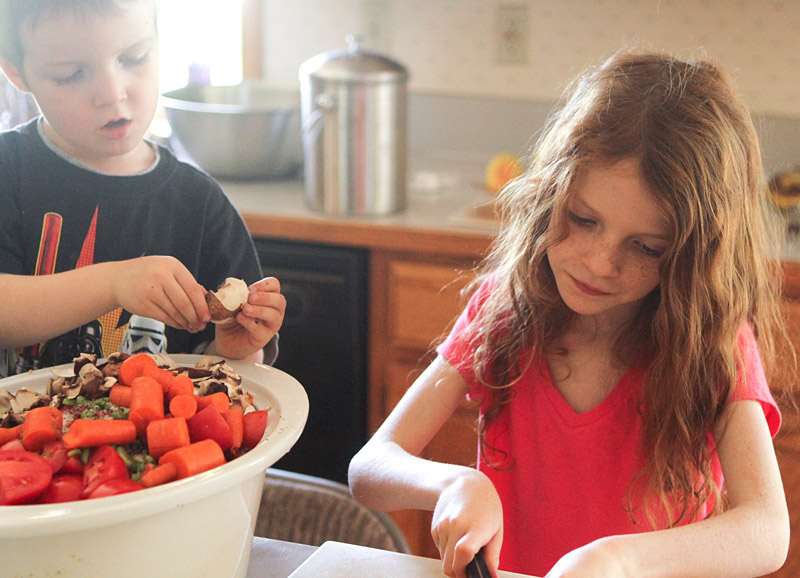
Remember that food preferences are totally normal! You’re not a worse parent because your child is particular. Continue to offer a variety of healthy foods with love, and everyone wins.
Special Challenges when Transitioning to Plant-Based
It can be very intimidating to consider removing many (all?) foods your kids like from the menu: cheese, chicken, their favorite spaghetti sauce, processed snacks, pepperoni pizza, etc. That’s a big deal!

The great news is that kids are much more adaptable than we give them credit for. Their palates can change pretty quickly given the right environment.
When I switched my diet (as an adult who was fully on board with the health benefits), I disliked all vegetables but two: raw baby carrots and corn on the cob. I gave myself space to eat lots of food I already loved that were plant-based, and time to try new things. That meant oatmeal for breakfast (Related: Serve Oatmeal for Breakfast if at all Possible) and some variation of black beans daily. I found that removing the junk food from my diet did something pretty wonderful: The flavors of whole foods started to come alive. Fruit was sweeter. Broccoli wasn’t bitter anymore. As I tried new recipes that sounded good, I naturally expanded the number of foods I enjoyed. Within six months, there was hardly a vegetable I didn’t like!
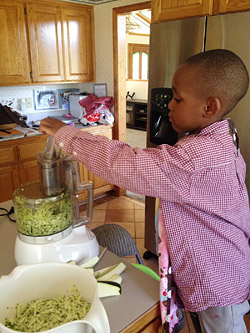
Although our children have always eaten plant-based, we have hosted many children in our home through the Safe Families for Children program and we’ve always been able to find plant-based food these kids liked to feed them at first as they settle in, and we’ve expanded from there so that within a week or so, they are munching on fresh fruit and veggies between meals, and sitting down to meals they would had turned their noses up to when they first arrived.
These kids do have the benefit of positive peer pressure as they watch my other kids chow on what I served, so be patient with how the process unfolds at your house.
Some suggestions to start: black beans (of course!) and rice, black bean soup, spaghetti sauce and pasta, refried bean burritos, and tomato bisque. For other meals: nut butter with whole grain bread, vegan whole grain waffles, fruit smoothies and muffins.
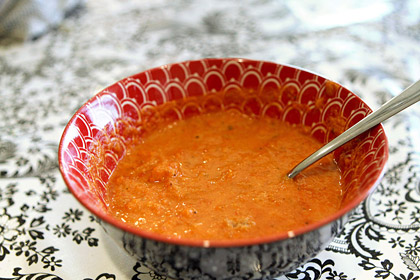
If something you like can be easily adapted to be plant-based (like simply leaving the cheese off), that’s a good place to start. If you love chili, it’s easy to find a new and delicious plant-based recipe. But, for older kids and adults, I recommend steering clear of “substitutes” like vegan mac & cheeze at first (note the ominous “z” in cheeze). Stick with common ground that doesn’t have to be the same as before in order to be appreciated. Later, after palates have changed, it might be fun to experiment with adapting old favorites to be plant-based.
Have empathy when it comes to your choosy family members as you make different food for them. Change is hard for all of us!

Success story! My five-year-old hasn’t had broccoli in 2 years, or hardly any veg for that matter. At dinner, I told him about taking a “polite bite” out of one piece of broccoli. He said “yuck” and threw it back in the serving bowl. I tried to keep calm as I told him tastebuds change over time and that he used to love broccoli, and how would he know if he likes it again unless he takes a small bite. So he did! And he liked it! He said “I can’t believe it happened this day!” (referring to his tastbuds changing) Then he ate 4 more. I was so happy I could cry.
Love this! We do the same. They get to start out with small helping of every food we’ve cooked for that meal. And they know they have to eat at least one bite of each food before they can ask for seconds on anything else. We’ve finally got two of the three eating salads now.
Very cool. I’m always glad to hear when principles work in other homes as well.
Great tips!! Need to try them out on some people I know!
Love and agree with all your points. Though both my kids are really good eaters but these can be very helpful tips. Thanks!!
I LOVE this article. My kids are super pic…I mean, they don’t like a lot of things yet. But I have had to switch to plant-based for health reasons and I would like them to eat healthier as well. Love the idea of not criticizing but finding a positive. You’ve given me some great ideas.